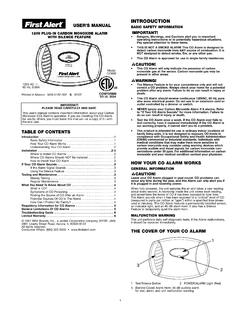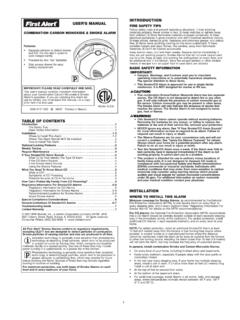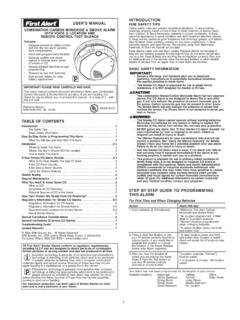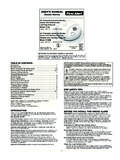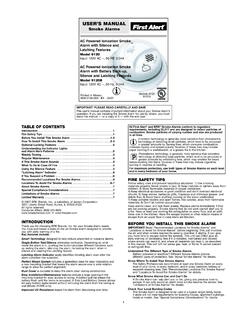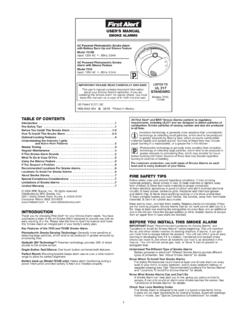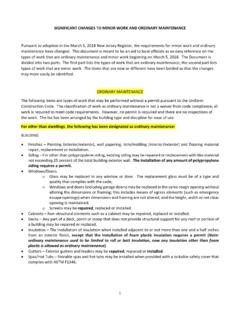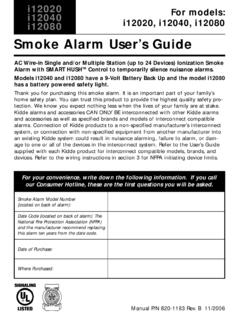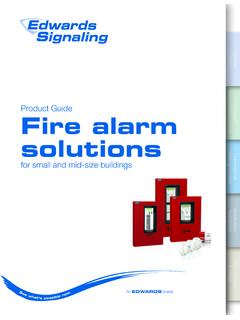Transcription of USER’S MANUAL INTRODUCTION Smoke & Carbon …
1 1 INTRODUCTIONT hank you for choosing BRK Brands, Inc. for your Smoke and CarbonMonoxide Alarm needs. You have purchased a state-of-the-art Smoke &CO Alarm designed to provide you with early warning of a fire or CarbonMonoxide. Key features include: Smoke & Carbon monoxide Combination alarm protectsagainst two deadly household Sensing Technologydesigned to help reduce unwanted ornuisance Interconnectcan be interconnected to BRK Smoke Alarms. One interconnect wire carries both Smoke and CO alarm Button Test/Silenceeliminates confusion. Depending on whatmode the alarm is in, pushing the button provides different functionssuch as testing the alarm, silencing the alarm, re-testing the alarmwhen in silence and clearing the Latching Alarm Indicatoreasily identifies initiating alarm even after thealarm condition has Mount Systemincludes a gasketless base for easy installationand a new mounting bracket that keeps the alarm secure over a widerotation range to allow for perfect Coveris included to keep the alarm clean during Installation/Maintenancefeatures include a large opening in the mounting bracket for easy access to wiring.
2 A battery pull tab thatkeeps the battery fresh until the home is occupied. A Side Load BatteryDrawer allows for easy battery replacement without removing the alarmfrom the ceiling or UV Resistancekeeps the alarm from discoloring over BRK and First Alert Smoke Alarms conform to regulatoryrequirements, including UL217 and are designed to detect particlesof combustion. Smoke particles of varying number and size are produced in all technology is generally more sensitive than photo-electric technology at detecting small particles, which tend to beproduced in greater amounts by flaming fires, which consumecombustible materials rapidly and spread of thesefires may include paper burning in a wastebasket, or a grease fire inthe technology is generally more sensitive than ionizationtechnology at detecting large particles, which tend to be producedin greater amounts by smoldering fires, which may smolder forhours before bursting into flame.
3 Sources of these fires may include cigarettes burning in couches or maximum protection, use both types of Smoke Alarms oneach level and in every bedroom of your S MANUALS moke & CarbonMonoxide AlarmAACC PPoowweerreedd SSmmookkee &&CCaarrbboonn MMoonnooxxiiddee AAllaarrmm wwiitthh BBaatttteerryy BBaacckk--uupp,,SSiilleennccee FFeeaattuurree aanndd LLaattcchhiinngg AAllaarrmmModel SC9120 BInput: 120V AC ~60 Hz, !! PPLLEEAASSEE RREEAADD CCAARREEFFUULLLLYY AANNDD SSAAVVEEThis user s MANUAL contains important information about your Alarm soperation. If you are installing the Alarm for use by others, you must leavethis MANUAL or a copy of it with the end in MexicoM08-0094-006 K1 08/08 TABLE OF CONTENTSI ntroduction ..1 Fire Safety Tips ..1-2 Installation ..2-4 Where To Install This Alarm ..2 Where This Alarm Should Not Be Installed ..2 Before You Begin Installation.
4 3 How To Install This Smoke /CO Alarm ..3-4 Using the Optional Locking Features ..5 How Your Smoke /CO Alarm Works ..6 Understanding the Light and Horn Patterns ..6If Your Smoke /CO Alarm Sounds ..6-7 What To Do First Identify the Type of Alarm ..6 What To Do if CO is Detected ..6 What To Do if Smoke is Detected ..6-7 Smart Interconnect Feature ..7 Using the Silence Feature ..7 The Latching Alarm Indicator ..7 Weekly Testing ..7 Regular Maintenance ..7 What You Need To Know About CO ..8 What is CO? ..8 Symptoms of CO Poisoning ..8 Finding the Source of CO After an Alarm ..8 Potential Sources of CO in the Home ..8 How Can I Protect My Family From CO Poisoning? ..8 Regulatory Information For Smoke /CO Alarms ..8-9 Regulatory Information for CO Alarms ..8 Regulatory Information for Smoke Alarms ..9 About Smoke Alarms ..9 Special Compliance Considerations ..9 General Limitations Of Smoke /CO Alarms.
5 10 Troubleshooting Guide ..10 Limited Warranty ..11 2008 BRK Brands, Inc. All rights by BRK Brands, Liberty Street Road, Aurora, IL 60504-8122 Consumer Affairs: (800) 323-9005 SAFETY TIPSF ollow safety rules and prevent hazardous situations: 1) Use smokingmaterials properly. Never Smoke in bed. 2) Keep matches or lightersaway from children; 3) Store flammable materials in proper containers; 4) Keep electrical appliances in good condition and don t overload elec-trical circuits; 5) Keep stoves, barbecue grills, fireplaces and chimneysgrease- and debris-free; 6) Never leave anything cooking on the stoveunattended; 7) Keep portable heaters and open flames, like candles,away from flammable materials; 8) Don t let rubbish alarms clean, and test them weekly. Replace alarms immediately if they are not working properly. Smoke Alarms that do not work cannotalert you to a fire.
6 Keep at least one working fire extinguisher on everyfloor, and an additional one in the kitchen. Have fire escape ladders orother reliable means of escape from an upper floor in case stairs SAFETY INFORMATION Dangers, Warnings, and Cautions alert you to important operating instructions or to potentially hazardous situations. Pay special attention to these items. This Smoke /CO Alarm is approved for use in single-familyresidences. It is NOT designed for marine or RV use. This combination Smoke / Carbon monoxide Alarm has twoseparate alarms. The CO Alarm is not designed to detect fire or any other gas. It will only indicate the presence of carbonmonoxide gas at the sensor. Carbon monoxide gas may bepresent in other areas. The Smoke Alarm will only indicate thepresence of Smoke that reaches the sensor. The Smoke Alarmis not designed to sense gas, heat or TOUL 217 andUL 2034 STANDARDS2 INSTALLATIONWHERE TO INSTALL THIS ALARMM inimum coverage for Smoke Alarms, as recommended by theNational Fire Protection Association (NFPA), is one Smoke Alarm onevery floor, in every sleeping area, and in every bedroom (See Regulatory Information For Smoke Alarms for details on the NFPA recommendations).
7 For CO Alarms,the National Fire Protection Association (NFPA) recommends that a CO Alarm should be centrally located outside ofeach separate sleeping area in the immediate vicinity of the added protection, install additional CO Alarms in each separate bedroom, and on every level of your home. In general, install combination Smoke and Carbon MonoxideAlarms: On every level of your home, including finished attics and basements. Inside every bedroom, especially if people sleep with the door partlyor completely closed. In the hall near every sleeping area. If your home has multiple sleeping areas, install a unit in each. If a hall is more than 40 feet (12 meters) long, install a unit at each end. At the top of first-to-second floor stairs. At the bottom of the basement stairs. For additional coverage, install Alarms in all rooms, halls, and storageareas, where temperatures normally remain between 40 F and 100 F (4 C and 38 C).
8 Recommended Placement When installing on the wall, the top edge of Smoke Alarms shouldbe placed between 4 inches (102 mm) and 12 inches (305 mm)from the wall/ceiling line. When installing on the ceiling, place the alarm as close to the center as possible. In either case, install at least 4 inches (102 mm) from where the wall and ceiling meet. See Avoiding Dead Air Spaces for :For any location, make sure no door or other obstruction couldkeep Carbon monoxide or Smoke from reaching the Smoke /CO Alarms in Mobile HomesFor minimum security install one Smoke /CO Alarm as close to eachsleeping area as possible. For more security, put one unit in each older mobile homes (especially those built before 1978) have littleor no insulation. If your mobile home is not well insulated, or if you areunsure of the amount of insulation, it is important to install units oninside walls THIS ALARM SHOULD NOT BE INSTALLEDDo NOT locate this Smoke /CO Alarm: In garages, kitchens, furnace rooms, crawl spaces and unfinishedattics.
9 Avoid extremely dusty, dirty or greasy areas. Where combustion particles are produced. Combustion particlesform when something burns. Areas to avoid include poorly ventilatedkitchens, garages, and furnace rooms. Keep units at least 20 feet (6 meters) from the sources of combustion particles (stove, furnace,water heater, space heater) if possible. In areas where a 20-foot (6 meter) distance is not possible in modular, mobile, or smallerhomes, for example it is recommended the Smoke /CO Alarm beplaced as far from these fuel-burning sources as possible. Theplacement recommendations are intended to keep these Alarms at a reasonable distance from a fuel-burning source, and thus reduce unwanted alarms. Unwanted alarms can occur if a Smoke /COAlarm is placed directly next to a fuel-burning source. Ventilate these areas as much as possible. Within 5 feet ( meters) of any cooking appliance.
10 In air streamsnear kitchens. Air currents can draw cooking Smoke into the smokesensor and cause unwanted alarms. In extremely humid areas. This Alarm should be at least 10 feet (3 meters) from a shower, sauna, humidifier, vaporizer, dishwasher,laundry room, utility room, or other source of high humidity. In direct sunlight. In turbulent air, like near ceiling fans or open windows. Blowing airmay prevent CO or Smoke from reaching the sensors. In areas where temperature is colder than 40 F (4 C) or hotter than100 F (38 C). These areas include non-airconditioned crawl spaces,unfinished attics, uninsulated or poorly insulated ceilings, porches,and garages. In insect infested areas. Insects can clog the openings to the sensing chamber. Less than 12 inches (305 mm) away from fluorescent lights. Electrical noise can interfere with the sensor. In dead air spaces. See Avoiding Dead Air Spaces.
